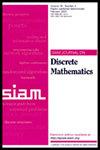Functors on Relational Structures Which Admit Both Left and Right Adjoints
IF 1
3区 数学
Q2 MATHEMATICS
引用次数: 0
Abstract
SIAM Journal on Discrete Mathematics, Volume 38, Issue 3, Page 2041-2068, September 2024.Abstract. This paper describes several cases of adjunction in the homomorphism preorder of relational structures. We say that two functors [math] and [math] between thin categories of relational structures are adjoint if for all structures [math] and [math], we have that [math] maps homomorphically to [math] if and only if [math] maps homomorphically to [math]. If this is the case, [math] is called the left adjoint to [math] and [math] the right adjoint to [math]. Foniok and Tardif [Discrete Math., 338 (2015), pp. 527–535] described some functors on the category of digraphs that allow both left and right adjoints. The main contribution of Foniok and Tardif is a construction of right adjoints to some of the functors identified as right adjoints by Pultr [Reports of the Midwest Category Seminar IV, Lecture Notes in Math. 137, Springer, 1970, pp. 100–113]. We generalize results of Foniok and Tardif to arbitrary relational structures, and coincidently, we also provide more right adjoints on digraphs, and since these constructions are connected to finite duality, we also provide a new construction of duals to trees. Our results are inspired by an application in promise constraint satisfaction—it has been shown that such functors can be used as efficient reductions between these problems.
关系结构上既允许左相接又允许右相接的函数
SIAM 离散数学杂志》,第 38 卷第 3 期,第 2041-2068 页,2024 年 9 月。 摘要本文描述了关系结构同态前序中的几种邻接情况。如果对于所有结构[math]和[math],当且仅当[math]同态映射到[math]时,我们说关系结构稀类之间的两个函子[math]和[math]是邻接的。如果是这种情况,[math] 被称为[math]的左邻接,[math] 被称为[math]的右邻接。Foniok 和 Tardif [Discrete Math., 338 (2015), pp.Foniok 和 Tardif 的主要贡献是构建了 Pultr [Reports of the Midwest Category Seminar IV, Lecture Notes in Math.137, Springer, 1970, pp.]我们将 Foniok 和 Tardif 的结果推广到任意关系结构,巧合的是,我们还提供了更多关于数图的右邻接,由于这些构造与有限对偶性相关联,我们还提供了树对偶的新构造。我们的结果受到承诺约束满足应用的启发--事实证明,这些函数可以用作这些问题之间的有效还原。
本文章由计算机程序翻译,如有差异,请以英文原文为准。
求助全文
约1分钟内获得全文
求助全文
来源期刊
CiteScore
1.90
自引率
0.00%
发文量
124
审稿时长
4-8 weeks
期刊介绍:
SIAM Journal on Discrete Mathematics (SIDMA) publishes research papers of exceptional quality in pure and applied discrete mathematics, broadly interpreted. The journal''s focus is primarily theoretical rather than empirical, but the editors welcome papers that evolve from or have potential application to real-world problems. Submissions must be clearly written and make a significant contribution.
Topics include but are not limited to:
properties of and extremal problems for discrete structures
combinatorial optimization, including approximation algorithms
algebraic and enumerative combinatorics
coding and information theory
additive, analytic combinatorics and number theory
combinatorial matrix theory and spectral graph theory
design and analysis of algorithms for discrete structures
discrete problems in computational complexity
discrete and computational geometry
discrete methods in computational biology, and bioinformatics
probabilistic methods and randomized algorithms.

 求助内容:
求助内容: 应助结果提醒方式:
应助结果提醒方式:


